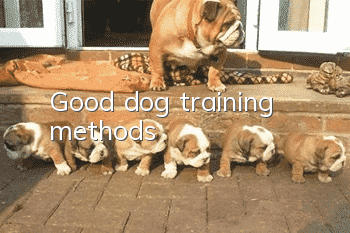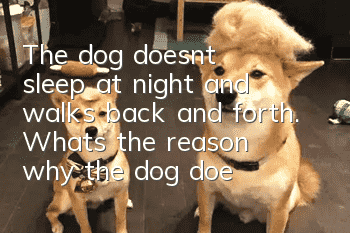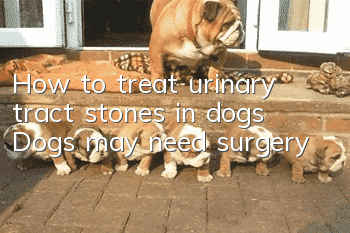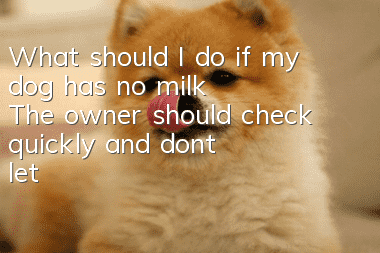Good dog training methods

1. Training dogs to be obedient Dogs do not understand what people say, so they must rely on gestures and intonations for training. If a puppy defecates everywhere, you should first say something to stop it, and then take an action to stop it, such as saying "no" and raising your hand to make a "hit" action. Whenever a guest comes to visit, the dog will also become excited and will often sniff around the front and back of the guest's feet, which often makes the guest feel very nervous. If the dog can be stopped and allowed to leave at this time, it will appear that the dog is well-educated and the owner has trained it well. In order to train the dog to be obedient, the owner should stand in front of the dog, give the command "Don't move", and at the same time push his right hand forward in a refusal gesture. If the dog wants to move, hold it forward, give the "don't move" command, point your finger in the direction of the kennel, give the "go back" command, and then pull the dog into the kennel and ask it not to move. . If the dog tries to run away, hold it down while firmly saying "No". If the dog returns to the den according to the command, caress and reward it in time. This is done by repeating the training many times. 2. Train the dog to urinate and defecate in a fixed place. The most important thing for a toy dog kept at home is not to urinate and defecate anywhere. Otherwise there would be no reward at all. This kind of training is best started with young dogs. Because puppies have poor ability to control their defecation before they are 3 to 4 months old. They will urinate everywhere after their bladders are filled with urine, or when they encounter stimulation and interference. Under normal circumstances, puppies need to urinate 10 to 20 times a day and defecate more than 4 to 5 times a day. The training method is: place a newspaper in a fixed place, smear dog urine on it, and when the dog wants to excrete (sniff around), take it to the newspaper. As soon as it smells urine, it will pee on the newspaper. . During training, attention should be paid to not moving the newspapers and not scrubbing the floor with smelly disinfectant so that the dog can find the place to defecate through the smell. Those who cannot go to the designated place to defecate every time will be punished once they are found. In addition, when dogs go out, they have the habit of peeing on the roadside to mark their dogs. This is a dog's nature and should be distinguished from urinating and urinating anywhere. However, on city streets, this habit of dogs also hinders hygiene. Therefore, when dog owners take their dogs out, they must wear a collar and use a leash to guide them. It would be ideal if you could train your dog to go to the toilet to defecate. 3. Train the dog to assume a graceful posture. First, hold the dog on the small table, let its hind legs close to the edge of the small table, and let go of the hand. The dog is afraid of falling, so its limbs become weak and wants to lie down. At this time, we have to Hold the dog's chest or chin with one hand, and gently pull the dog's tail back with the other hand. Be careful not to pull only the tail hair, so as not to cause pain. The hand holding the chest also pushes back to prevent the dog from sitting down. When the dog realizes that the support of its hind feet will be lost and it will be empty if it retreats further, it will instinctively lean forward and straighten up, with its forelimbs firmly planted and its toes tightened, showing a standard of straight limbs and head held high. posture. As long as this method is repeated many times, the dog will learn it. Even if it stands on flat ground in the future, as long as we hold the tail and pull it backward, the dog will reflexively assume a standard graceful posture. 4. Sit down. This is a component of training combined with other subjects. The trained dog is required to quicklyAnd make the action of sitting down correctly and be able to hold it for a certain period of time. During training, let the dog stand on the left side of the owner, and while giving the "sit" command, lift the collar with your right hand and press the dog's waist corner with your left hand. When the dog is forced to sit down under this mechanical stimulation, it should be rewarded immediately. After repeated training many times, the dog can develop the movement of sitting down. On this basis, training is carried out in conjunction with gestures. If you are asked to sit on the front, stretch your right upper arm flat outwards, your forearm is vertical upward, and the palm of your hand moves forward to form an "L" shape; if you are asked to sit on the left side, tap your left abdomen with your left hand. If the dog can already do the "sitting" action, it should be gradually trained to extend the time it can sit, from being able to sit for 3 to 5 seconds until it is extended to more than 5 minutes. 5. Lying down: The action of lying down should be performed after the "sitting" action has been learned. During training, two methods can be used: First, the owner is on the right side of the dog, facing the dog, holding the food in his right hand, slowly moving from the top of the dog's mouth to the bottom, and at the same time giving the lie down command, and pulling the leash downward. , to stimulate. At this time, the dog can lie down under food and mechanical stimulation. When the dog lies down, reward it with food in time. In the future, as the conditioned reflex develops, rewards and stimulation will be gradually removed. Another method is to make the dog sit down. The owner should squat down, hold the dog's two forelimbs with both hands, stretch them forward, and press the dog's shoulder blade with his left arm. The dog will then lie down. At this time, he should be given Reward with food. In the future, the dog should be trained within a certain distance and combined with gestures (left arm drooped, palm forward, palm down, and waving up and down) to improve its level of action, extend the command distance, and be able to follow the owner's command The ability to lie down for more than 5 minutes with hand gestures. 6. Standing During training, the shilling dog sits down, then gently pulls the leash, giving the "stand" command and gesture (stretch your right arm toward the dog, palm upward). When the dog stands, reward it. The owner should gradually leave the dog's side so that the dog can stand longer. On this basis, gradually develop the ability to stand according to gestures or commands and last for a certain period of time. 7. Perform the bowing exercise on the basis of the "standing" movement. During training, the owner stands opposite the dog and first gives the "stand" command. When the dog stands firmly, he gives the "thank you" command. At the same time, he grabs the dog's forelimb with one hand and swings it up and down. After repeating it several times, reward it with petting and food. Then keep a distance from the dog and no longer use your hands to assist when giving commands. If the dog can't do it, repeat it a few more times until the dog can do it. At the beginning of training, you can add some simple gestures, but you must prevent the dog from conditioned reflexes to the gestures. When the movements are very stable, as long as the command "thank you" is given, the series of reflex activities of standing and bowing will be completed in one go, without the need to give the command twice.
Random articles
- Dog’s anal gland odor, please note that this is a sign of your dog’s health!
- How to make your dog like to eat dog food Four ways to make your dog fall in love with dog food
- How to protect your dog’s food? Teach you tips on training your dog
- Why do dogs defecate everywhere? How can dogs stop defecating everywhere?
- What should I do if my dog has lupus? Immune system diseases should not be underestimated
- If your dog's hair is cut and the skin is cut, the flesh is exposed. If the dog's hair is accidentally cut and the skin is cut, it must be disinfected immediately.
- Do dogs need deworming in summer? What should you pay attention to when raising dogs in summer?
- What to do if your dog has indigestion? Dog indigestion is no small matter!
- What should you pay attention to when vaccinating your dog? What should you pay attention to when vaccinating your dog?
- Symptoms of Rheumatism in Dogs What conditions can cause rheumatism in dogs?



